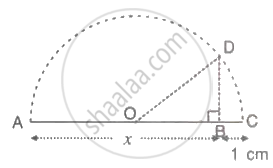Advertisements
Advertisements
प्रश्न
In the following, find the values of a and b:
`(3 + sqrt(7))/(3 - sqrt(7)) = "a" + "b"sqrt(7)`
उत्तर
`(3 + sqrt(7))/(3 - sqrt(7)`
= `(3 + sqrt(7))/(3 - sqrt(7)) xx (3 + sqrt(7))/(3 + sqrt(7)`
= `(3 + sqrt(7))^2/((3)^2 - (sqrt(7))^2`
= `(9 + 6sqrt(7) + 7)/(9 - 7)`
= `(16 + 6sqrt(7))/(2)`
= `8 + 3sqrt(7)`
= `"a" + "b"sqrt(7)`
Hence, a = 8 and b = 3.
APPEARS IN
संबंधित प्रश्न
Rationalize the denominator.
`1/(sqrt 7 + sqrt 2)`
Rationalize the denominator.
`(sqrt 5 - sqrt 3)/(sqrt 5 + sqrt 3)`
Rationalise the denominators of : `(2sqrt3)/sqrt5`
Rationalise the denominators of : `1/(sqrt3 - sqrt2 )`
Simplify the following
`(sqrt(5) + sqrt(3))/(sqrt(5) - sqrt(3)) + (sqrt(5) - sqrt(3))/(sqrt(5) + sqrt(3)`
Simplify the following :
`(4sqrt(3))/((2 - sqrt(2))) - (30)/((4sqrt(3) - 3sqrt(2))) - (3sqrt(2))/((3 + 2sqrt(3))`
In the following, find the values of a and b:
`(5 + 2sqrt(3))/(7 + 4sqrt(3)) = "a" + "b"sqrt(3)`
In the following, find the values of a and b:
`(1)/(sqrt(5) - sqrt(3)) = "a"sqrt(5) - "b"sqrt(3)`
If x = `(7 + 4sqrt(3))`, find the value of
`x^2 + (1)/x^2`
Using the following figure, show that BD = `sqrtx`.

